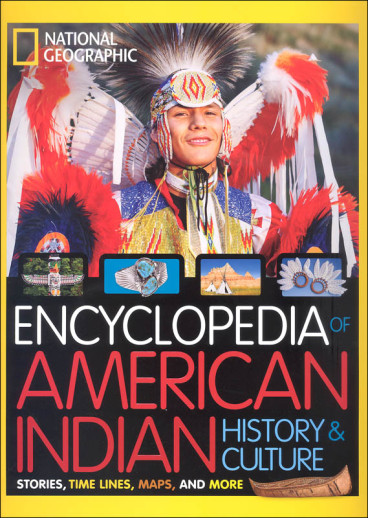We use cookies to make your experience better. To comply with the new e-Privacy directive, we need to ask for your consent to set the cookies. Learn more.
National Geographic Kids Encyclopedia of American Indian History and Culture
Learn some Native History about more than a hundred tribes, including the tribe's name, language, “Hello/How are you?" and “Thank you" in their language, and location (previous and current). Each tribe has 1 – 2 pages of information about the tribe. Pictures and paintings of the tribal people, as well as dishes, clothes, hunting, and activities may be featured as well. The book is separated into the following 8 main sections according to geographic location: The Arctic and Subarctic, The Northeast, The Southeast, The Plains, The Southwest, The Great Basin and Plateau, The Northeast Coast, and California. There is a map that shows the different divisions, and maps at each section that show where each of the tribes lived. Note: Keep in mind some of the paintings or pictures may depict people wearing very little clothing.
American Indian customs, stories, and history come to life in this important and authoritative reference, artfully designed and packaged for kids and students.
More than 160 tribes are featured in this outstanding new encyclopedia, which presents a comprehensive overview of the history of North America's Native peoples. From the Apache to the Zuni, readers will learn about each tribe's history, traditions, and culture, including the impact of European expansion across the land and how tribes live today. Features include maps of ancestral lands; timelines of important dates and events; fact boxes for each tribe; bios of influential American Indians such as Sitting Bull; sidebars on daily life, homes, food, clothing, jewelry, and games; Did You Know facts with photographs; and traditional Native stories. The design is compelling and colorful, packed with full-color photographs.
To help give kids the lay of the land, this reference is arranged by region, and all federally recognized tribes are included. With nothing comparable available, it is sure to be a valuable resource for kids, students, librarians, and families.
| Product Format: | Hardcover |
|---|---|
| Grades: | 3-7 |
| Brand: | National Geographic Society Children's Books |
| ISBN: | 9781426334535 |
| Length in Inches: | 12.125 |
| Width in Inches: | 9.5 |
| Height in Inches: | 1 |
| Weight in Pounds: | 3.8 |


We want to cover something about Native American history each year.
We are going to focus on Native/Indigenous Americans for Social Studies this year and this book will be our spine.